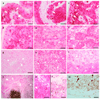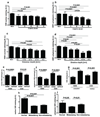Expression of vitamin D receptor decreases during progression of pigmented skin lesions
- PMID: 21292298
- PMCID: PMC3078192
- DOI: 10.1016/j.humpath.2010.09.014
Expression of vitamin D receptor decreases during progression of pigmented skin lesions
Abstract
1,25-dihydroxyvitamin D3 affects proliferation, differentiation, and apoptosis and protects DNA against oxidative damage with a net tumorostatic and anticarcinogenic effect. It acts through a specific nuclear receptor that is widely distributed through the body. Although a beneficial role of vitamin D in melanoma patients has been suggested, there is lack of information on the changes in the expression pattern of vitamin D receptor during progression of pigmented lesions. Using immunohistochemistry, we analyzed the expression of vitamin D receptor in 140 samples obtained form 82 patients, including 25 benign nevi, 70 primary cutaneous melanomas, 35 metastases, 5 re-excisions, and 5 normal skin biopsies. The strongest expression was observed in normal skin that significantly decreased in melanocytic proliferations with the following order of expression: normal skin > melanocytic nevi > melanomas = metastases. The vitamin D receptor expression in skin surrounding nevi and melanoma was also significantly reduced as compared to normal skin. Tumor-infiltrating and lymph node lymphocytes retained high levels of vitamin D receptor. There was negative correlation between tumor progression and vitamin D receptor expression with a remarkable decrease of the immunoreactivity in nuclei of melanoma cells at vertical versus radial growth phases and with metastatic melanomas showing the lowest cytoplasmic receptor staining. Furthermore, lack of the receptor expression in primary melanomas and metastases was related to shorter overall patients' survival. In addition, the receptor expression decreased in melanized melanoma cells in comparison to amelanotic or poorly pigmented cells. Therefore, we propose that reduction or absence of vitamin D receptor is linked to progression of melanocytic lesions, that its lack affects survival of melanoma patients, and that melanogenesis can attenuate receptor expression. In conclusion, changes in vitamin D receptor expression pattern can serve as important variables for diagnosis, predicting clinical outcome of the disease, and/or as a guidance for novel therapy of melanomas based on use of vitamin D or its derivatives.
Copyright © 2011 Elsevier Inc. All rights reserved.
Figures







Similar articles
-
Expression of the vitamin D-activating enzyme 1α-hydroxylase (CYP27B1) decreases during melanoma progression.Hum Pathol. 2013 Mar;44(3):374-87. doi: 10.1016/j.humpath.2012.03.031. Epub 2012 Sep 17. Hum Pathol. 2013. PMID: 22995334 Free PMC article.
-
Beclin 1 and LC3 autophagic gene expression in cutaneous melanocytic lesions.Hum Pathol. 2010 Apr;41(4):503-12. doi: 10.1016/j.humpath.2009.09.004. Epub 2009 Dec 11. Hum Pathol. 2010. PMID: 20004946
-
Cadherin expression pattern in melanocytic tumors more likely depends on the melanocyte environment than on tumor cell progression.J Cutan Pathol. 2004 Jan;31(1):1-7. doi: 10.1046/j.0303-6987.2004.0106.x. J Cutan Pathol. 2004. PMID: 14675278
-
Role of In Vivo Reflectance Confocal Microscopy in the Analysis of Melanocytic Lesions.Acta Dermatovenerol Croat. 2018 Apr;26(1):64-67. Acta Dermatovenerol Croat. 2018. PMID: 29782304 Review.
-
Black and Brown Oro-facial Mucocutaneous Neoplasms.Head Neck Pathol. 2019 Mar;13(1):56-70. doi: 10.1007/s12105-019-01008-2. Epub 2019 Jan 29. Head Neck Pathol. 2019. PMID: 30693458 Free PMC article. Review.
Cited by
-
Mining gene expression signature for the detection of pre-malignant melanocytes and early melanomas with risk for metastasis.PLoS One. 2012;7(9):e44800. doi: 10.1371/journal.pone.0044800. Epub 2012 Sep 11. PLoS One. 2012. PMID: 22984562 Free PMC article.
-
Differential antitumor effects of vitamin D analogues on colorectal carcinoma in culture.Int J Oncol. 2015 Sep;47(3):1084-96. doi: 10.3892/ijo.2015.3088. Epub 2015 Jul 17. Int J Oncol. 2015. PMID: 26260259 Free PMC article.
-
The Role of the Vitamin D Receptor in the Pathogenesis, Prognosis, and Treatment of Cutaneous Melanoma.Front Oncol. 2021 Oct 6;11:743667. doi: 10.3389/fonc.2021.743667. eCollection 2021. Front Oncol. 2021. PMID: 34692525 Free PMC article. Review.
-
Expression of Vitamin D Receptor (VDR) Positively Correlates with Survival of Urothelial Bladder Cancer Patients.Int J Mol Sci. 2015 Oct 15;16(10):24369-86. doi: 10.3390/ijms161024369. Int J Mol Sci. 2015. PMID: 26501255 Free PMC article.
-
Association among Vitamin D, Retinoic Acid-Related Orphan Receptors, and Vitamin D Hydroxyderivatives in Ovarian Cancer.Nutrients. 2020 Nov 19;12(11):3541. doi: 10.3390/nu12113541. Nutrients. 2020. PMID: 33227893 Free PMC article.
References
-
- Holick M, MacLaughlin JA, Clark MB, Holick SA, Potts JT, Anderson RR, Blank IH, Parrish JA, Elias P. Photosynthesis of previtamin D3 in human skin and the physiologic consequences. Science. 1980;210:203–205. - PubMed
-
- Holick M. Vitamin D: A millenium perspective. J Cell Biochem. 2003;88:296–307. - PubMed
-
- Lehmann B. Role of the vitamin D3 pathway in healthy and diseased skin-facts, contradictions and hypotheses. Exp Dermatol. 2009;18:97–108. - PubMed
-
- Kramer C, Seltmann H, Seifert M, Tilgen W, Zouboulis CC, Reichrath J. Characterization of the vitamin D endocrine system in human sebocytes in vitro. J Steroid Biochem Mol Biol. 2009;113:9–16. - PubMed
Publication types
MeSH terms
Substances
Grants and funding
LinkOut - more resources
Full Text Sources
Medical

